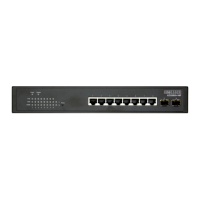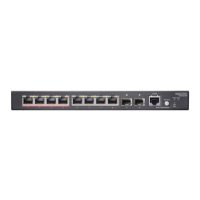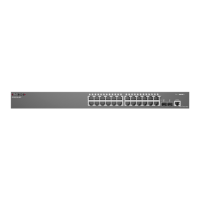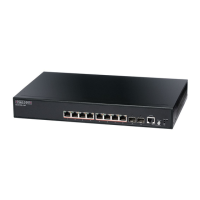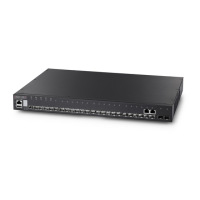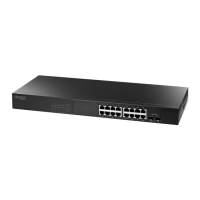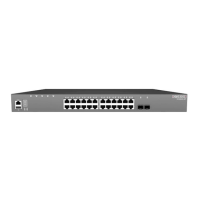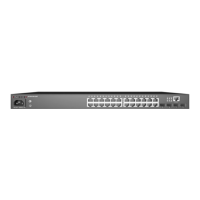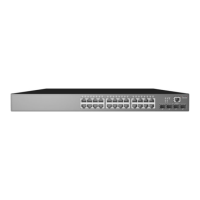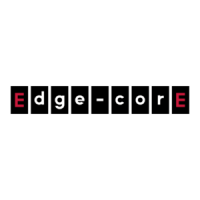
Do you have a question about the Edge-Core ECS2000-10P and is the answer not in the manual?
| Model | ECS2000-10P |
|---|---|
| Type | Managed Switch |
| Ports | 10 |
| PoE Ports | 8 |
| PoE Budget | 130W |
| Switching Capacity | 20 Gbps |
| Forwarding Rate | 14.88 Mpps |
| Layer | Layer 2 |
| MAC Address Table Size | 8K |
| Weight | 3.5 kg |
| Power over Ethernet | IEEE 802.3af/at |
| Power Supply | AC 100-240V, 50/60Hz |
| Operating Temperature | 0 to 50 °C |
| Storage Temperature | -40 to 70 °C |
| Humidity | 10% to 90% (non-condensing) |
Details the FCC Class A compliance for digital devices, outlining performance standards.
States compliance with EU directives for Electromagnetic Compatibility and safety standards.
Covers specific safety warnings and precautions, including fiber optic port safety.
Provides essential safety guidelines for connecting and using the power cord.
Highlights critical warnings and cautions for safe operation and handling of the device.
Outlines the manufacturer's commitment to environmental sustainability in product design and production.
Explains the objective of the guide: detailing switch hardware features and installation procedures.
Identifies the intended readers as network administrators with basic LAN knowledge.
Defines the symbols and conventions used throughout the guide for conveying information.
Summarizes the changes made in each revision of the installation guide.
Provides a general introduction to the ECS2000-10P switch, its features, and capabilities.
Describes the switch's wire-speed, non-blocking switching fabric and store-and-forward operation.
Explains how the switch can be monitored and managed via LEDs and a web browser.
Details the Power over Ethernet (PoE) capabilities, including standards and power budget.
Provides a detailed breakdown of the switch's physical components like ports and slots.
Explains the function and status indications provided by the switch's LEDs.
Identifies the location and type of the power inlet on the switch.
Instructs on proper grounding procedures to prevent electrical shock and damage.
Describes the function and location of the reset button for restoring default configurations.
Introduces network switching technology and its importance in modern networking.
Details various network setup scenarios and configurations for the switch, including collapsed backbone.
Explains how to use the switch for Power over Ethernet (PoE) connectivity with compatible devices.
Illustrates how to collapse complex networks into a single efficient node for increased throughput.
Covers connecting network segments using fiber optic cables for extended reach and high-speed links.
Guides on organizing network nodes into separate broadcast domains using VLANs for security and efficiency.
Provides important tips and considerations for network setup and operation, including cable length limits.
Provides guidelines for choosing an optimal location for installing the switch.
Details the requirements and criteria for suitable Ethernet cabling for switch installation.
Lists all components included in the package and other necessary installation equipment.
Specifies the additional equipment needed for mounting the switch in a rack.
Covers general mounting considerations, including rack-mounting factors like temperature and grounding.
Provides instructions for mounting the switch on a wall using provided brackets.
Explains how to place the switch on a desktop or shelf for operation.
Details the procedure for connecting the switch to an AC power source.
Guides on how to install SFP transceivers into the switch for fiber optic connectivity.
Details how to connect various network devices like PCs, servers, and hubs to the switch.
Describes how to connect PoE-compliant devices and the switch's power delivery capabilities.
Explains the requirements and methods for connecting devices via twisted-pair cables with RJ-45 connectors.
Provides instructions for making network connections within wiring closets using patch panels.
Guides on installing and connecting fiber optic SFP transceivers for network links.
Outlines rules for network connectivity, including cable requirements and performance limits for different Ethernet types.
Emphasizes the importance of labeling cables and maintaining connection records for easier management.
Helps diagnose issues by explaining the meaning of different LED statuses on the switch.
Provides troubleshooting steps for common installation-related problems with the switch.
Offers solutions for issues related to accessing the switch's management agent over the network.
Lists the physical dimensions, weight, temperature, and humidity specifications of the switch.
Details the switch's forwarding mode, throughput, and flow control features.
Describes the available management features, including in-band management options.
Lists the various industry standards that the switch complies with.
Details the emissions, immunity, and safety compliances of the switch, including CE Mark.
